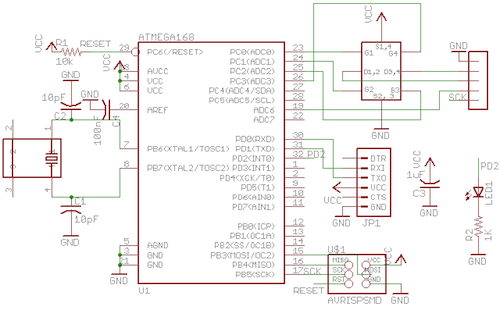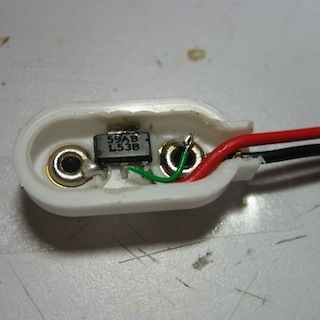We've seen quite a few cool clocks made with our products over the years. We even have one of our own proudly displayed right by reception! But this project from from SparkFun customer Matt Keeter is one of the best we've seen. Check it out!
Matt's Slideclock uses two motorized slide potentiometers and a custom-designed PCB based on an ATMega168 microcontroller. Matt designed the PCB in Eagle which uses an H-Bridge for motor control, a 32.768 KHz clock crystal for timekeeping, an LED, and various other parts.

The schematic of Matt's Slideclock.
Matt designed the board so the microcontroller can be programmed through the on-board SPI header. There is also an FTDI header for debugging/serial communication and a five-pin header to connect to the slide potentiometer. He also put some useful features into the firmware for his clock, most notably a power-saving sleep mode where the microcontroller spends most of its time. Timer2 interrupts the sleep every second to keep the time accurate.

Like any good engineer, Matt thought outside of the box.
Matt designed the case in CAD and cut it out of some scrap wood using a laser cutter. The one hiccup he ran into during his design was that he forgot to include a voltage regulator on his board - which he solved via a pretty darn clever modification to his battery plug that you can see above.
The final result is impressive! Check out Matt's website for more information on this project as well as some of his other designs. Great job!







I'd be too tempted to mess with the slides!
Don't do that, you'll cause a rift in the time-space continuum!
O--
t'noD--
N--
Ooo--
!--
Don--
't--
!!!--
--!!!lla su llik ll'uoY
I would assume that the slders are available to set the time for when you find that RTC's aren't that reliable...
I would assume moving the sliders allows you to time-travel up to +/-24h. Everybody can see that C3 is a SMD-sized flux capacitor! XD
Lottery anyone?
His voltage regular fix is a clever fix, but I feel very uncomfortable using that for any extended period of time.
Call me old fashioned, but I feel that those solder joints can break from repeatable plugging and unplugging on it. And when that happens and you don't notice the Vreg missing? Stuff can happen.
/end safety rant
I hope that he makes a second revision of the board and incorporate it on there, or a more permanent fix to the 9V plug.
Not to mention that a locked motor would literally melt the whole connector on heat dissipation :P
Heh. You could set it up to set the alarm by sliding the pots manually and pressing an "Alarm set" button. Then have the motor reset the slide back to the correct time.
Of course, you'll need an AM/PM light and a way to set that.
I want to make one of these, but using decade counters. Maybe I could make one that just does minutes... and moves reeeaaallllyyy slllooowwwlllyyy.
Looks great! Was thinking of the same thing when I saw those sliders.
+sparkfun please!!!
Yes! I'd like a re-do on the last 5 minutes, can I just slide the knob back? Seriously, the project is uniquely brilliant. Every hour on the hour the minute slider resets back to the beginning, much like the coo-coo clocks of old mark the beginning of an hour. This seems to have, dare I say, a bit of steam-punk inspiration.
This is awesome. Would also be really cool vertically aligned.
Nice hack on the modification to the battery plug.